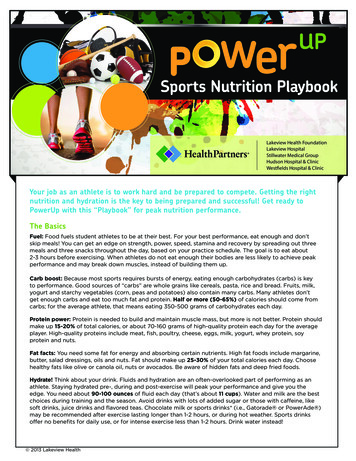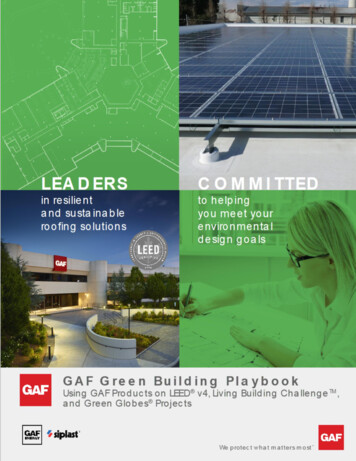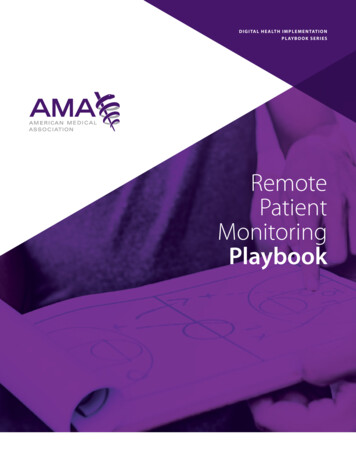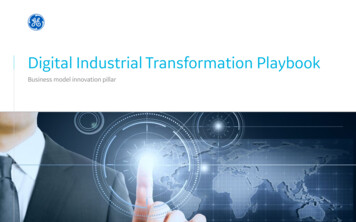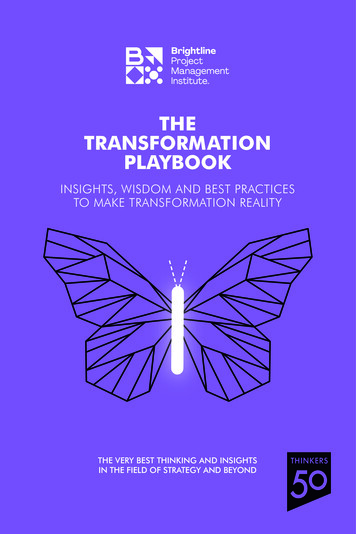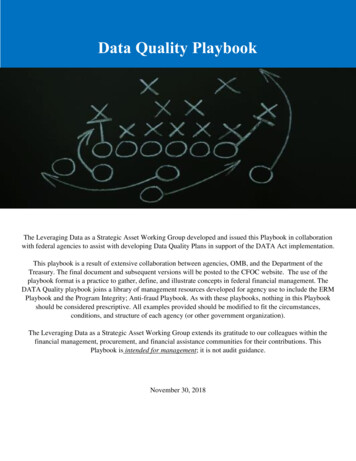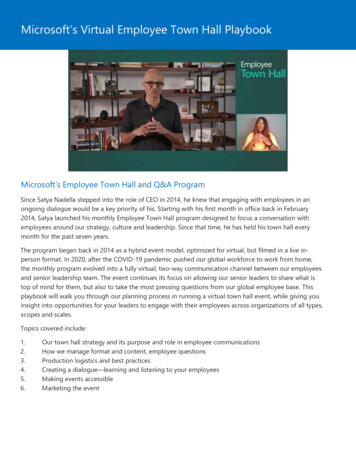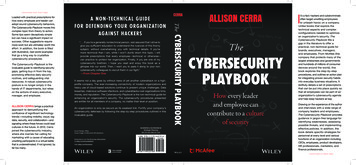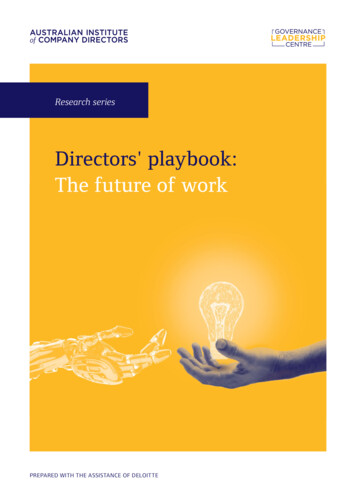
Transcription
Research seriesDirectors' playbook:The future of workPREPARED WITH THE ASSISTANCE OF DELOITTE
218 Jamison StreetSydney NSW 2000t: 61 2 8248 6600f: 61 2 8248 6633e: publications@companydirectors.com.auw: www.companydirectors.com.auThe Australian Institute of Company Directors is committed to excellence in governance. We make apositive impact on society and the economy through governance education, director development andadvocacy. Our membership of more than 43,000 includes directors and senior leaders from business,government and the not-for-profit sectors.Disclaimer The material in this publication does not constitute legal, accounting or other professionaladvice. While reasonable care has been taken in its preparation, the Australian Institute of CompanyDirectors does not make any express or implied representations or warranties as to the completeness,reliability or accuracy of the material in this publication. This publication should not be used or reliedupon as a substitute for professional advice or as a basis for formulating business decisions. To the extentpermitted by law, the Australian Institute of Company Directors excludes all liability for any loss ordamage arising out of the use of the material in the publication.Any links to third party websites are provided for convenience only and do not represent endorsement,sponsorship or approval of those third parties, any products and services offered by third parties, or asto the accuracy or currency of the information included in third party websites. The opinions of thosequoted do not necessarily represent the view of the Australian Institute of Company Directors.Copyright Copyright strictly reserved. The text, graphics and layout of this guide are protected byAustralian copyright law and the comparable law of other countries. The copyright of this material isvested in the Australian Institute of Company Directors. No part of this material can be reproduced ortransmitted in any form, or by any means electronic or mechanical, including photocopying, recordingor by any information storage and retrieval systems without the written permission of the AustralianInstitute of Company Directors. Australian Institute of Company Directors 2018Published in October 2018
3DIRECTORS' PLAYBOOK: THE FUTURE OF WORKForewordWork is changing. The way it is done, the skills andtools we use and the places in which work happensare constantly evolving. Today’s workplaces arealmost unrecognisable from those mere decadesago, and the pace of change only seems to beaccelerating.Boards play a crucial role in navigating the changingnature of work, seeking to be alert to the challenges andopportunities it presents.The Australian Institute of Company Directors (AICD) iscommitted to assisting boards to chart a course throughthe changing nature of work. Governance is critical indoing this. Work is changing for every company andgovernance must keep pace.This document explores the trends that influence thechanging nature of work through a governance lens.It examines how new ways of working will affect thegovernance of companies and distils the practical lessonsthat have the greatest importance to boards.One of the most important changes for boards willconcern how decisions that require emotional and ethicaljudgement are made in the context of organisationswhere an increasing number of decisions are made byartificial intelligence.Angus Armour FAICDManaging Directorand Chief Executive OfficerAustralian Instituteof Company DirectorsKee Wong FAICDDirector, Australian Instituteof Company DirectorsChair, AICD TechnologyGovernanceand Innovation Panel“ The future of work shouldbe on every board’s agenda.”In February of 2018, the AICD held the first meetingof its Technology Governance and Innovation Panel.This panel brings together directors and executives withrelevant experience in Australia and globally to advisethe AICD on its work in supporting directors to governtechnology and innovation.The Technology Governance and Innovation Panel is apractical demonstration of our commitment to helpingAustralian boards to grapple with the modern challengespresented by issues like the future of work. Thisdocument is the first project of the panel.We are grateful for the assistance of Deloitte who havecontributed to the development of this report and to themembers of the Technology Governance and InnovationPanel for their guidance and input.We trust that this report will be of use to boards as theyprepare to face an exciting but challenging future of work.
4DIRECTORS' PLAYBOOK: THE FUTURE OF WORKContentsPage5INTRODUCTIONWhat was1.0 WORKThe nature and typeof work being done2.0 WORKERThe workforce capabilitiesand composition requiredto carry out the work3.0 WORKPLACEThe physical, digital, culturaland structural environmentrequired to carry out the workCONCLUSIONWork of handsWhat will be8Work of mindsData light10Data drivenCommercial focus12Purpose drivenTechnical skills14Soft skillsHuman workers18Augmented workforcePermanent and homogenous20Contingent and diverseAd hoc training22Lifelong learningWork/life separation24Wellbeing at workSilos28Networks of teamsPositional power30Personal powerReactive32Nimble and innovativeTraditional office35Frictionless space36
5DIRECTORS' PLAYBOOK: THE FUTURE OF WORKIntroductionDirectors are operating in an environment characterisedby constant change, uncertainty and increasing complexity.One of the most significant changes concerns the future ofwork. Which tasks will still be required? Who will do them,and what skills will they need? What environments willthey work in?The impact of these changes on governance is profound.The way organisations are governed must adapt, anddirectors will need to take informed and considered steps totake advantage of the opportunities presented. Governancemust be flexible in its response to the changing nature ofwork as well as providing oversight and strategic directionfor new ways of working.The playbookThis playbook aims to give directors an overview of someof the key trends and evidence on the future of work. Itsgoal is to help directors better understand the governancedimensions of this issue and provide practical insights tohelp take advantage of the opportunities these workforcetrends present.The impact of these changes for directors are examinedthrough a six-point lens based on the key roles of the board:2StrategyBoards establish strategies toguide, monitor and control theorganisation’s activitiesResourcesBoards oversee resourceallocation required to achievethe strategyPerformanceBoards monitor theorganisation’s performanceagainst its strategies and targetsComplianceBoards ensure there areadequate processes in place tocomply with legal and regulatoryrequirementsRiskBoards oversee a sound riskmanagement framework thatsupports the company innegotiating uncertaintiesAccountabilityBoards report progress andalign the collective interests ofstakeholdersOf course, there are no simple answers.The impact of the future of work varies across industries,geographies and business models. This guide is not intendedto equip directors with solutions, but with a set of questionsthat will support more informed decision making.To give structure to this complex topic, this playbookconsiders the future of work from three perspectives, eachwith its own chapter: Work – the nature and type of work being done; Worker – the workforce capabilities and compositionrequired to carry out the work; and Workplace – the physical, digital, cultural and structuralenvironments required to carry out the work.1Each chapter is divided into four components of work –looking at both the current trend and a possible view of thefuture. These issues are interrelated; for example, changes inwork tasks will necessarily require new skills and a changingworkforce. As such, there is some overlap between topics.Each section includes ‘questions for directors’ whichaim to stimulate discussion and reflection by boardson how changes in the nature of work might affecttheir organisation, having regard to their own uniquecircumstances.In some places, the distinction between the role ofmanagement and the board may be less clear than others.Some boards will inquire into these issues on a moregranular level, whereas others may remain more strategic intheir focus. This playbook provides additional backgroundinformation and analysis to support boards to understandthe operational issues that underpin changes in the futureof work beyond its impact on governance.1It’s (almost) all about me: Workplace 2030. Deloitte, 2013, ure-work-amp-2013.pdf2Based on the Company Directors Course run by AICD.
6WORK1.0
DIRECTORS' PLAYBOOK: THE FUTURE OF WORKWORK1.0 WORKThe nature and type of work being doneWork is the fundamental building block of business. It is the ‘what’ and ‘how’ of business activity- where the business's value is created.Work is changing. New technologies and shifting consumer behaviours are redefining what worktasks are required to create value.Manual or physical tasks are still necessary in many industries, but these no longer require asmuch human input. Instead, employment is more concentrated in service-based tasks.As a result, tasks and roles are less focused on technical and mechanical requirements. Work tasksincreasingly require a combination of technical and soft skills to create value.Evidence (or data) is becoming the basis of more tasks, particularly those that include elements ofdecision making or judgement. The exponential growth in the volume and breadth of data presentsnew opportunities, but also challenges.This evidence is complemented by a growing recognition of the need to look beyond the balancesheet to longer-term value generation. Many businesses now look to align work tasks to anoverarching ‘purpose’ and there is a growing demand for companies to operate in a socially andenvironmentally responsible way.7
DIRECTORS' PLAYBOOK: THE FUTURE OF WORKWORK1.1 Work of hands vs work of mindsIndustry 4.0, the fourth industrial revolution, is “blurringthe lines between the physical, digital and biologicalspheres”.3 Human history has experienced significanttechnological change before, but the speed, scope andimpact of the current transformation is unprecedented.4Figure 2: Shift in Australian workforce composition,1984 to 201730%25%25%22%Figure 1: The four industrial 0%5%0%1234Source: Deloitte Access EconomicsWhile significant economic value is still generated bymanual labour, employment associated with many ofthese tasks is in decline.Today, the mining industry employs just 2 per cent of theAustralian workforce but is responsible for 9 per cent ofvalue added, while the health and social assistance industryemploys 10 per cent of the workforce and generates 7 percent of value added.5In the United Kingdom, employment in caring jobs (jobsfocused on service provision such as in healthcare) hasgrown from 1 per cent of the workforce in 1871 to 12 percent in 2015, while ‘muscle power’ jobs (jobs focused onmanual tasks such as manufacturing) have fallen from 24per cent to 8 per cent.A similar shift can be observed in Australia (Figure 2).Today, service industries employ almost 80 per cent of theAustralian workforce – approximately 9.8 million people.1984Muscle power2017CaringSource: ABS 2017, 6291.0 – Labour Force, Australia, DetailedLooking aheadAs technology replaces many manual labour tasks, relianceon human workers for these tasks will continue to decrease.Augmented by technology, workers will apply both theirminds and their hands to higher functions and there will bea greater blurring of the two.Computers and technology will become increasinglyeffective at tasks previously considered only appropriatefor humans – the ‘work of the heart’. Developments inartificial intelligence (AI) will enable technology to assess,interpret and mimic human reasoning, making it better ableto communicate in a personal way, exercise judgement andsolve complex problems.In this world, human workers will be managers and trainers,monitoring, assessing and approving the decisions made bycomputers. Successful companies will recognise that thesetechnologies are most effective when they complementhumans, not replace them.3World Economic Forum 2016, The Fourth Industrial Revolution: what it means, how to respond, accessed online July 2018 via pond/4World Economic Forum 2016, The Fourth Industrial Revolution: what it means, how to respond, accessed online July 2018 via pond/5ABS 2017, 8155.0 – Australian Industry, 2016-17, and, 6291.0 – Labour Force, Australia.8
DIRECTORS' PLAYBOOK: THE FUTURE OF WORKWORK?This change might also mean that the current trend of outsourcing labourto other parts of the world may reverse. With AI doing more of theheavy lifting, demand for cost-effective labour may fall. Instead, otherconsiderations such as freight costs and proximity to other parts of thesupply chain may drive decisions about where to locate workforces.This trend toward work automation will be more pronounced in someindustries than in others. For instance, automation is initially having a moresignificant effect on manufacturing than education, though this may changeover time.What does it mean for skAccountabilityQUESTIONS FORDIRECTORS1.Have we quantified whatwork is being done andhow it might be affectedby developments intechnology?2. How do we communicateabout AI augmentation toour staff and employees?A key focus for boards should be overseeing design and implementation ofa strategy that navigates a changing labour market effectively and whichhas the flexibility to respond to unexpected change.The tools available to a business (and its competitors) will change rapidly,and directors may need to consider strategies with shorter lifecycles or whichcan be more readily changed to respond to this shifting dynamic.Directors will also need to be prepared to be accountable for the impactof technology on their human workforces. Automation can enhancebusiness productivity, but downsizing workforces can be seen as a breachof community expectations. Downsizing can also result in workforcedisengagement and can adversely impact a company’s reputation, whichmay also have commercial consequences.Boards should consider the potential impact of automation on issues suchas headcount and be satisfied that staff have been engaged in processes tounderstand any impact on their jobs.Investing in minor automations may not displace workers in the short term,but the development of these technologies is exponential. How and when amass adoption of artificial intelligence may occur is a matter of debate amongexperts, and boards must accept this as a key risk in decision making on thismatter. Many of the impacts of AI on the workforce are largely unknown.3. How do we best engagethe redundant humancapacity generated byautomation?4. What ethical frameworkwill we use to makedecisions about theseissues?5. What assumptions arepresent in our decisionmaking about AI giventhe uncertain nature of itsdevelopment?9
DIRECTORS' PLAYBOOK: THE FUTURE OF WORKWORK1.2 Data light vs. data drivenThe capabilities of technology are expanding quickly. Moore’s Law statesthat the number of transistors on computer circuits doubles every two years.This exponential development has occurred in other areas such as the powerdensity of batteries and DNA sequencing.Consumer adoption of technologies is also capable of keeping pace withthis rapid development. Twitter took two years to accrue 50 million users,compared to the 38 years it took radio to reach 50 million people.Figure 3: Time taken to reach 50 millions usersTelephone75Aeroplane68Car62RadioThis exponential adoption oftechnology means that the volumeof data generated is growingsignificantly. Currently, the worldgenerates 2.5 quintillion bytes ofdata every day, and 90 per centof the world’s total data has beencreated in the last two years.6 Everyminute of 2017 saw 3.6 millionGoogle searches, 15 million textsand 154,000 Skype calls.7Businesses of all sizes are investingto harness the opportunities thatmass creation of data presents. In2017, only 11 per cent of smallbusinesses were rated ‘basic’ on adigital engagement scale, comparedto 35 per cent in 2013.8Figure 4: Digital engagementamong small businesses over time3816%Television1425%World Angry 17HighBasicSource: Deloitte Access Economics 2017,01020304050607080Connected Small Business 2017.YearsSource: Tech Today (2017)6IFLScience 2017, How much data does the world generate every minute?, accessed online March 2018 via does-the-world-generate-every-minute/7Domo 2017, Data never sleeps 5.0, accessed online March 2018 via https://www.domo.com/learn/data-never-sleeps-5?aid ogsm072517 1&sf100871281 18Deloitte Access Economics 2017, Connected Small Business 2017.10
DIRECTORS' PLAYBOOK: THE FUTURE OF WORKWORKLooking aheadAs more data is generated, the insights that can be extracted from it will grow.Businesses will become more aware of their data and its value – and manywill change the way they operate to improve the volume and quality of datacollected. Data-driven decision making will be the norm.Data will also be recognised as a balance sheet asset. Leaders will invest in andmaintain this asset for the value it brings to their business, but also consider it acommercial product in and of itself. There will also be greater recognition that, asan asset, data can be lost, damaged or stolen.The increase in data available will create greater transparency within businessesand, when combined with advanced analytical tools, unlock new insights. Forexample, businesses will be able to analyse what employees are doing and talkingabout in real time (through analysing their computer usage or using naturallanguage processing).Stakeholders too will have greater access to data about businesses. Publiclyavailable data sources will enhance the ability of consumers and investors tomake informed decisions about their interactions with business.What does it mean for skAccountabilityAs stakeholders gain greater accessto data about businesses, boardsshould also consider how theyreport on their performance in away that complements the data thatstakeholders already have availableto them. In some cases, stakeholderswill be able to develop their ownperformance metrics for companies,and boards will need to consider howthis affects public perception of theirperformance.?QUESTIONS FORDIRECTORS1. How is our data protectedagainst misuse, damage,loss or theft?Data is no longer a by-product – it is an asset. Directors should think about howtheir business is collecting, using and protecting data.It can be used internally to monitor performance or improve processes, andexternally to better understand customers, workers and suppliers. Like otherassets, it should be subject to appropriate controls and oversights in terms of use,access, development and ownership.In this context, directors should consider how to use data to drive performance,particularly to inform decision making. Directors will have access to real-timeperformance data that can assist to make timely decisions.Making the most of this data within the constraints of time-limited andinfrequent board meetings may present challenges. Boards should exploreoptions for digital tools that enable collaboration outside of board meetings toanalyse data, ask questions and even make decisions in real time.Directors will also need to be conscious of protecting this asset, and ensurethe business is compliant with data security and privacy laws. Data breachescan cause significant damage to a business – and managing this will becomemore important as the volume of data generated continues to grow (and theconsequences for misuse become more severe).Directors are accountable to stakeholders and have a responsibility to protecttheir data. However, they also need to recognise that data breaches do happenand be satisfied that in the event of a breach there is a plan in place to minimisedamage to stakeholders and the company.2. Are the implicationsof a data breach fullyunderstood and costed?3. Have we considered usingdata from a third party,particularly if we do nothave the resources tocollect our own?4. Are we aware of and are wemeeting our obligations tostakeholders as custodiansof their data?5. What data do ourstakeholders have aboutour performance and howdo we measure up?11
DIRECTORS' PLAYBOOK: THE FUTURE OF WORKWORK1.3 Commercial focus vs purposePerformance expectations of businesses in relation toenvironmental, social and governance (ESG) issues aregrowing among the community, governments and investors.In 2015-16, Australian businesses donated a total of 17.5 billion to the community in the form of money,goods and services.9 In 2017, 88 per cent of Australianand New Zealand businesses reported that practising socialresponsibility helped them to build their reputation, and78 per cent say it contributed to brand positioning.10Today some of the most influential voices in promotingsocially and environmentally responsible corporatebehaviour are institutional investors, who increasinglyexpect that companies have a solid vision for long-termvalue creation. For example, Larry Fink, Founder and CEOof Blackrock, recently released a letter to fellow CEOs on theimportance of purpose-led work.11Millennials, in particular, expect business to be purpose-led.They are more than twice as likely to prefer to work at asustainable company, pay extra for sustainable products andcheck product packaging for sustainable labelling as theircounterparts in Generation X, and more than four times aslikely to do so compared with baby boomers.12A recent global survey of executives found that onlytwo-in-five businesses globally are ‘purpose-led’.13This may increase as millennials age and take a largerrole in management ranks. However, whether theseperceptions will change over time is unknown.Looking aheadTraditional paradigms that portray big businesses asimpersonal and profit driven, and smaller businesses ascommunity-minded could be reversed. Big businessesare more likely to have the resources to plan and sustainlong-term value-creation strategies and to spend onsocial and environmental initiatives. By comparison,smaller businesses, competing for survival, may have anincreasingly narrow focus on the bottom line.Regardless of size, businesses that are not cognisant ofcommunity expectations may be penalised by investors,consumers and indeed governments. It seems likely thatthere will be an increasing focus on conduct, culture andcorporate responsibility as governments grapple withaddressing declining trust in institutions.Consumers will be more inclined to do business with firmsthat have a social purpose they support, and that giveback to the community. Today, 86 per cent of millennialsthink that business success should be measured in termsof more than just financial performance14, and as thisgeneration takes on a greater share of leadership roles,businesses that let purpose rather than simply profitdictate strategy will have an advantage.“There will be an increasing focus on conduct, culture andcorporate responsibility as governments grapple withaddressing declining trust in institutions.”9Australian Government, Prime Minister’s Community Business Partnership (2016), Giving Australia 2016, accessed online August 2018 via -content/uploads/2017/04/giving australia 2016 fact sheet -business giving and volunteering accessible 3.pdf10ACCSR (2017), Re-imagining sustainable value: the Sustainable Development Goals gather pace, accessed online August 2018 via SR-State-of-CSR-Report-2017.pdf11BlackRock 2017, A Sense of Purpose, accessed online August 2018 via ions/larry-fink-ceo-letter12Nielson 2014, Doing well by doing good, accessed online February 2018 via 4.pdf13Harvard Business Review 2016, The business case for purpose, accessed online February 2018 via ortEY.pdf14Deloitte 2017, The 2017 Deloitte millennial survey: Apprehensive millennials: Seeking stability and opportunities in an uncertain world.12
DIRECTORS' PLAYBOOK: THE FUTURE OF WORKWORKWhat does it mean for skAccountability?QUESTIONS FORDIRECTORSEmbedding elements of purpose within strategy requires thought, input andauthorisation of the board. Directors should take an active role in identifyingcommunity expectations and overseeing strategies to ensure they areconsidered, understood and met.1. Have we identified ourstakeholders and theirexpectations of ourbusiness?For organisations to be truly purpose driven, boards will need to developpractices that enable them to align decision-making practices with theorganisation’s purpose, balancing their purpose against financial andoperational considerations without neglecting their legal duties.2. How do we incorporateconsiderations of purposeinto decision making?Directors will need to make resources available to develop purpose-ledinitiatives. As business becomes more cognisant of the value of trust andthe social licence to operate, boards will need to consider how the impactof investment in maintaining and developing it is measured.Increased focus on these issues may require a rethink of performancemeasurements. Today, most businesses measure their progress against strategicplans using largely financial metrics. However, directors should consider waysto assess the alignment of the organisation to its purpose and the social andeconomic impact of its activities.“Directors should consider waysto assess the alignment of theorganisation to its purpose and thesocial and economic impact of itsactivities.”As trust in political and community leaders declines,15 there is an opportunityfor business leaders – including directors – to play a more significant role inpublic life. There is a growing expectation that directors will take ultimateaccountability for the conduct of their business, and this presents anopportunity for directors to take a greater public role in representing thecompany and its work to the community.15Edelman 2018, 2018 Edelman Trust Barometer, accessed online July 2018 via https://www.edelman.com/trust-barometer3. How do we managestakeholders who may behostile to the business?4. How do we communicateour purpose tostakeholders?5. Do we measure our ESGperformance againstindustry benchmarks?13
DIRECTORS' PLAYBOOK: THE FUTURE OF WORKWORK1.4 Technical vs soft skillsSubject matter and technical expertise has always been highly valued bybusiness. But technology makes it easier to upskill quickly and there is nowless of a premium placed on certain subject matter expertise.Successful outcomes are no longer guaranteed by meeting technicalrequirements. Instead, success requires a combination of technical expertiseand soft skills.Of the 16 ‘crucial proficiencies in the 21st century’ identified by the WorldEconomic Forum, 10 are non-technical. Today, nearly three in four advertisedjobs list communication skills as a requirement, and one in four require digitalliteracy skills and critical thinking.16Figure 5: Soft skill attainment in Australia92.6%12.0%95.8%of Australiansreport having usedself-managementskills in their lastjobof graduates observeprofessional ethicsof Australians havethe highest level ofdigital literacyof graduates arerecognised byemployers fortheir capacityto problemsolve92.7%of graduateshave the abilityto understanddifferentviewpoints96.1%of graduatesdisplay thecapacity forteamwork4.6millionAustralians areemployed ininnovative business26.0%of Australiansreport having usedcommunication skillsin their last jobSource: Deloitte Access Economics 2017, Soft skills for business success.Deloitte Access Economics 2017, Soft skills for business success.Deloitte Access Economics 2017, Soft skills for business success.18Deloitte Access Economics 2017, Soft skills for business success.16176.2%Many technical skills have alreadybeen automated, and some soft skillsare also beginning to be outsourcedto technology. For example, Googlerecently launched AI software(Google Duplex) with communicationskills so advanced it can successfullycall and make a restaurantreservation without the restaurantemployee even realising they areinteracting with a program.Looking aheadWhile technologies are learningto understand and mimic humantone and emotion, they are lessable to exercise judgement or makedecisions that take account of widercontext. Higher order soft skillssuch as empathy, professional ethicsand emotional judgement will beincreasingly valued by business.Soft-skill intensive roles (e.g.managers, health professionals andcommunity workers) will grow muchfaster than more technical roles(e.g. clerical workers, labourers andsales support workers). By 2030,two-thirds of Australian jobs will besoft-skill intensive, compared to halfof Australian jobs in 2000.17Businesses are already facing anundersupply of critical soft skills – aquarter of employer
Contents DIRECTORS' PLAYBOOK: THE FUTURE OF WORK 4 Page INTRODUCTION 5 What was What will be 1.0 WORK Work of hands 8 Work of minds Data light 10 Data driven Commercial focus 12 Purpose driven Technical skills 14 Soft skills 2.0 WORKER Human workers 18 Augmented workforce Permanent and homogenous 20 Contingent and diverse Ad hoc training 22 Lifelong learning Work/life separation 24 Wellbeing .



